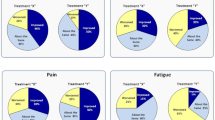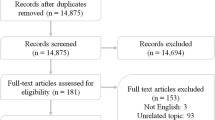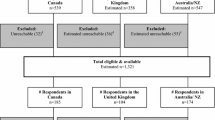Abstract
Health-related quality of life (HRQL) is a prevalent outcome measure in clinical trials, but it is not known how best to communicate HRQL results to new patients with cancer. The purpose was to explore cancer patients' attitudes toward, and preferences for, 10 visual and written formats for communicating HRQL information. Using standardized qualitative methods, six focus groups were held (two groups in each of three cancer centres) with patients who had completed treatment for cancer at least 6 months earlier. Groups were stratified according to patients' education. To ensure consistency across centres, group moderators used the same detailed guide, training video, and props. Three investigators independently coded the resulting transcripts. Participants also rated each of the 10 presentation formats as to their perceived usefulness. Fourteen men and 19 women with a variety of cancer diagnoses participated; 13 (39%) participated in the three lower-education groups and 20 (61%) in the three higher-education groups. We found that simple formats (simple graphs or written text) were generally preferred to more complex graphical information, regardless of educational level. The same format was rated favourably by the highest proportion of participants in both the high (85%) and low (85%) education level groups. Individual patients, however, varied as to which visual format they most preferred. Patients did not wish to receive HRQL information out of context or without explanation. We conclude that cancer patients desire HRQL information, but vary in their preferences for its communication. Simple formats are generally preferred.
Similar content being viewed by others
References
Davison J, Degner LF, Morgan TR. Information and decision-making preferences of men with prostate cancer. Oncol Nurs Forum 1995; 22: 1401–1408.
Sutherland HJ, Llewellyn-Thomas HA, Lockwood GA, Tritchler DL, Till JE. Cancer patients: Their desire for information and participation in treatment decisions. J Royal Soc Med 1989; 82: 260–263.
Wiggers JH, Donovan KO, Redman S, Sanson-Fisher RW. Cancer patient satisfaction with care. Cancer 1990; 66: 610–616
Cassileth BR, Zupkis RV, Sutton-Smith K, March V. Information and participation preferences among cancer patients. Ann Intern Med 1980; 92: 832–836.
Chaitchik S, Kreitler S, Shaked S, Schwartz I, Rosin R. Doctor-patient communication in a cancer ward. J Cancer Educ 1992; 7: 41–54.
Feldman-Stewart D, Brundage MD, Hayter C, et al. What questions do patients with curable prostate cancer want answered? Med Decision Making 2000; 20: 7–19.
Bezjak A, Taylor KM, Ng P, Macdonald K, DePetrillo AD. Quality-of-life information and clinical practice: The oncologist's perspective. Cancer Prevent Control 1998; 2: 230–235.
Greenfield S, Kaplan S, Ware JE. Expanding patient involvement in care. Ann Intern Med 1985; 102: 520–528.
Jacobs C, Ross RD, Walker IM, Stockdale FE. Behavior of cancer patients: A randomized study of the effects of education and peer support groups. Am J Clin Oncol (CCT) 1983; 6: 347–350.
Meyerowitz BE, Watkins IK, Sparks FC. Psychosocial implications of adjuvant chemotherapy. Cancer 1983; 52: 1541–1545.
Molleman E, Krabbendam PJ, Annyas AA, Kloops HS, Sleijfer DT, Vermey A. The significance of the doctor-patient relationship in coping with cancer. Social Sci Med 1984; 18: 475–480.
Wallace LM. Informed consent to elective surgery: The 'therapeutic' value? Social Sci Med 1986; 22: 29–33.
Aaronson NK, Ahmedzai S, Bergman B. The European Organization for Research and Treatment of Cancer QLQC30: A quality-of-life instrument for use in international clinical trials in Oncology. J Nat Cancer Inst 1993; 85: 365–376
de Haes JC, van Knippenberg FC. Quality of life instruments for cancer patients: 'Babel's Tower revisited'. J Clin Epidemiol 1989; 42: 1239–1241.
Cohen SR, Mount BM, Bruera E, Provost M, Rowe J, Tong. Validity of the McGill Quality of Life Questionnaire in the palliative care setting: A multi-centre Canadian study demonstrating the importance of the existential domain. Palliat Med 1997; 11: 3–20.
Cohen SR, Mount BM, Tomas JJ, Mount LF. Existential well-being is an important determinant of quality of life. Evidence from the McGill Quality of Life Questionnaire. Cancer 1996; 77: 576–586.
Till JE. Measuring quality of life: Apparent benefits, potential concerns. Can J Oncol 1994; 4: 243–248.
Browman GP. Science, language, intuition, and the many meanings of quality of life. J Clin Oncol 1999; 17: 1651–1653.
Gill TM, Feinstein AR. A critical appraisal of the quality of quality-of-life measurements. JAMA 1994; 272: 619–626.
Guyatt GH, Feeny DH, Patrick DL. Measuring health-related quality of life. Ann Intern Med 1993; 118: 622–629.
Neymark N, Kiebert W, Torfs K, et al. Methodological and statistical issues of quality of life (QoL) and economic evaluation in cancer clinical trials: Report of a workshop. Eur J Cancer 1998; 34: 1317–1333.
Anderson RT, Aaronson NK, Wilkin D. Critical review of the international assessments of health-related quality of life. Qual Life Res 1993; 2: 369–395.
Till JE, Osoba D, Pater JL, Young JR. Research on health-related quality of life: Dissemination into practical applications. Qual Life Res 1994; 3: 279–283.
Kiebert G, Wait S, Bernhard J, et al. Practice and policy of measuring quality of life and health economics in cancer clinical trials: A survey among co-operative trial groups. Qual Life Res 2000; 9: 1073–1080.
Osoba D, Dancey J, Zee B, Myles J, Pater J. Health-related quality-of-life studies of the National Cancer Institute of Canada Clinical Trials Group. J Nat Cancer Institute 1996; Monographs: 107–111.
Ashbury FD, Lockyer L, McKerracher K, Findlay H. Focus groups with cancer patients: Toward a more comprehensive understanding of the cancer experience. Cancer Prevent Control 1997; 1: 222–227.
Degner LF, Sloan JA. The control preferences scale. Can J Nurs Res 1997; 29: 21–43.
Feldman-Stewart D, Brundage MD, Nickel JC, Mackillop WJ. The information required by patients with early-stage prostate cancer in choosing their treatment. Brit J Urol Internat 2001; 87: 218–223.
Asbury J. Overview of focus group research. Qual Health Res 1995; 5: 414–420.
Morgan DL. Focus groups as qualitative research. Newbury Park, CA: Sage, 1988.
Krueger RA. Focus Groups: A Practical Guide for Applied Research, 2nd ed. Newbury Park, CA: Sage Publications, 1994.
Greenbaum ER. The Handbook for Focus Group Research, 2nd ed. Thousand Oaks, CA: Sage Publications, 1998.
Carey MA. Comment: Concerns in the analysis of focus group data. Qual Health Res 1995; 5: 487–495.
Carey MA, Smith MW. Capturing the group effect in focus groups: A special concern in analysis. Qual Health Res 1994; 4: 123–127.
Cleveland WS, McGill R. Graphical perception: Theory, experimentation, and application to the development of graphical methods. J Am Statist Assoc 1984; 79: 531–554.
Cleveland WS, McGill R. Graphical perception and graphical methods for analyzing scientific data. Science 1985; 229: 828–833.
Feldman-Stewart D, Kocovski N, McConnell B, Brundage M, Mackillop W. Perception of quantitative information for treatment decisions. Med Decision Making 2000; 20: 228–238.
Elting LS, Martin CG, Cantor SB, Rubenstein EB. Influence of data display formats on physician investigators' decisions to stop clinical trials: Prospective trial with repeated measures. Brit Med J 1999; 318: 1527–1531.
Ottenbacher KJ. When is a picture worth a thousand p values? A comparison of visual and quantitative methods to analyze single subject data. J Special Educ 1990; 23: 436–449.
Carswell CM. The art and psychological science of graphical communication. Psychol Sci Agenda 1995; 8–9.
Mazur DJ, Hickam DH. Interpretation of graphic data by patients in a general medicine clinic. J Gen Intern Med 1990; 5: 402–405.
Guyatt GH, Juniper EF, Walter SD, Griffith LE, Goldstein RS. Interpreting treatment effects in randomised trials. Br Med J 1998; 316: 690–693.
Author information
Authors and Affiliations
Rights and permissions
About this article
Cite this article
Brundage, M., Leis, A., Bezjak, A. et al. Cancer patients' preferences for communicating clinical trial quality of life information: A qualitative study. Qual Life Res 12, 395–404 (2003). https://doi.org/10.1023/A:1023404731041
Issue Date:
DOI: https://doi.org/10.1023/A:1023404731041




